
VOICE Home Page: http://www.os2voice.org
[Newsletter Index]
[Previous Page] [Next Page]
[Feature Index]

VOICE Home Page: http://www.os2voice.org |
November 2003
[Newsletter Index]
|
| By Mark Dodel © November 2003 |
In terms of content and process Warpstock 2003
was a great success. The event started off much more smoothly than any past event
I've attended. Pre-registered attendees were able to pick up their registration
packet on Friday evening in the exhibit hall. Several folks helped Network Coordinator
Michael Barnes with building the networking cables, and for the first time the internet
access seemed pretty effortless. We had wireless access in both the exhibit area
and in one of the session rooms. Next year we may just go entirely wireless.
Full registration started at about 7AM Saturday morning. This year we made sure we had coffee, tea, pastries and donuts available (on both Saturday and Sunday mornings) so this year registration went smoothly and provided a good start to the event.
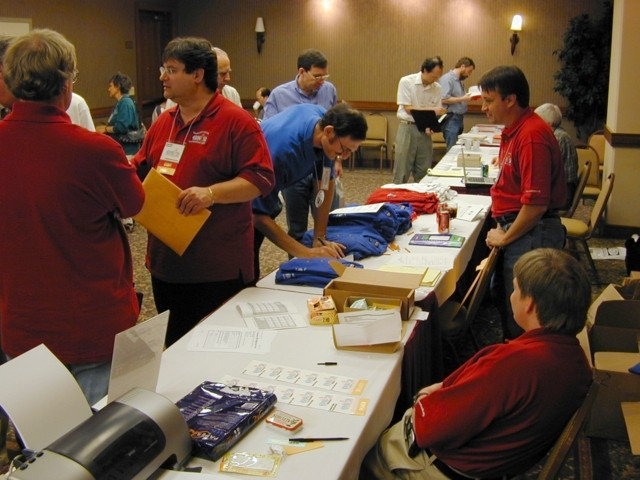
The actual opening session went quickly with just a brief introduction of the Baywarp event team who were responsible for putting on the show this year. This included event-chair Sam Little, Co-chair Neil Waldhauer, Speaker Coordinator Robert Kuropkat, Exhibitor Coordinator Paul Lazaga, Volunteer Coordinator Bill Usim, Registration Coordinator Gilbert D Lopez, Network Coordinator Michael Barnes and Publicity Coordinator Tim Cardozo.
I'd like to thank all these folks who made this one of the best, and smoothest running events I've been associated with. Robert did a great job of assembling a jam packed presentation schedule that filled 4 meeting rooms for most of two days. The only complaint I heard all weekend was that there was too many times people couldn't see a session because they wanted to see something else. I actually managed to go to 3 or 4 sessions myself, but missed seeing CDS' Disaster Recovery presentation, and Lewis Rosenthal's Wireless Networking session because I went to the Virtual Machine session. Stan Sidlov's session on Home Networking was packed with non-corporate users of OS/2 and eCS who were looking for tips and guidance on setting up a broadband connection and home network under our platform of choice.
In his session on the "IBM eClient Strategy" Oliver Mark stated the future for OS/2 according to IBM is "Server Based OS/2" (SBO) where it is run via Microsoft Virtual Server, Citrix Metaframe or other virtual machine. By virtualizing the hardware, the problems of hardware support are pretty much eliminated.
This year we heard that IBM has at least one customer contracting for OS/2 support through 2019 (yes that is 2019); There is no change to the 2006 end of program defect support date announced in the OS/2 Strategy by IBM; And that IBM's Software Group which is the owner of OS/2 wants everyone to move to Linux even though IBM itself makes a lot of money from OS/2, basically because it is other divisions within IBM that make the money, not them. On the upside IBM should be releasing Fixpack 4 shortly as it has been in internal testing for at least a couple months now. An MCP3 release may be considered but no decision has been made as to if or when a new CD set would be done.
Sun Microsystems and Innotek gave a presentation on OpenOffice.org and showed an early alpha release of OO.org running on OS/2. , Manish Punjabi manager of the OpenOffice.org division at Sun gave an overview of what to expect from all the components of OpenOffice.org:
Writer - A word processor which is interoperable with Microsoft Word.Note that unlike the monolithic structure of StarOffice 5.1, OpenOffice.org/StarOffice 7 is more a suite of individual applications.
Calc - A spreadsheet which is interoperable with Excel.
Impress - A presentation tool interoperable with PowerPoint.
Draw - A design/drawing tool similar to Visio but not supporting the Visio file format.
Base - A database application. In the StarOffice version this includes the ADABASE database engine. That is not included in the OpenOffice.org product.
The latest version of StarOffice is now at version 7 which was just shipped. StarOffice currently costs about $60/license retail. Though based on the same source as OpenOffice.org, StarOffice adds service, install support, training tools, 3rd part ISV support (i.e. ERP), a commercial spell checker, printed manual and CDs, and some other distinctions. Both versions support export to both PDF and Flash file formats as well as import/export of XML format (Excel 2002 XML and Office 2003 XML). It comes in many national language versions including Asian (I assume this means DBCS but didn't think to ask for a clarification at the time.) languages.
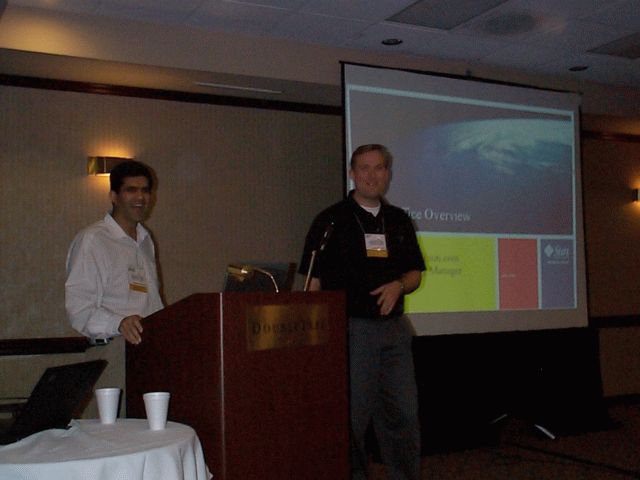
After Manish was done explaining OpenOffice.org Innotek's Oliver Stein explained what to expect from the OS/2 version. The source code for OpenOffice.org is about three times the size of the Mozilla source. To provide the product on OS/2 in the fastest most efficient manner they are using ODIN to port OpenOffice.org. OpenOffice.org for OS/2-eCS will have antialiased font support integrated into it. It will include the builtin database engine as well as ODBC. Its functionality will be identical to the current OpenOffice.org for Windows product.
Sourcecode will be available and Innotek will provide TCO (Total Content Ownership) versions for customers requiring special build line versions. Costs for the Innotek version will start at $29, but they will only sell a minimum of 100 licenses and up. Serenity Systems will handle retail sales, with those who have purchased the eComStation Application Pack receiving it as a free download, eCS users for $30, OS/2 users for $40. The initial alpha OS/2 version was shown at the session. Oliver stated that all applications are runnable, but are unstable. They expect a GA version by the end of this year.
I heard that Serenity has plans for a 1.2 or 2.0 release of eCS some time next year (maybe 2nd Quarter 2004 but I missed that session so I have no idea what that will encompass). We saw the new VM product (running on Linux and Windows, but an OS/2 host is being worked on) that they are working on as a replacement for VirtualPC for OS/2. This new VM was demoed in a session by Robert Henschel of NetSys GmbH. The original product, TwoOSTwo, was developed for German banks to run OS/2 applications on Windows hosts. They have been working with Serenity Systems to further develop an enduser product. The name most likely will be "Serenity Virtual Station". Initially that was for Linux/BSD as the Connectix VPC product was already established and running well under OS/2. An OS/2 host is in alpha development now, but the product was demoed in the session running on Linux. Both the Linux/BSD and OS/2 versions as well as the Windows version will be released together
Robert stated that when possible they route device calls to real hardware rather then emulation to improve performance. Currently the product supports direct routing to parallel and serial ports, floppy, CDROM, CPU, and RAM. Emulation of a VESA 3.0 graphics card (supported by Scitech's display driver) and Network emulation (NE2000(plus) either ethernet or tokenring). As with VPC/2, physical RAM needs to be reserved for the guest operating system. Future additions will include sound (SB16 emulation) and USB support. USB support will only be for devices already supported by the host platform. There is no PCMICA support, though any PCMCIA network card will work as long as the host has a supported driver for it.
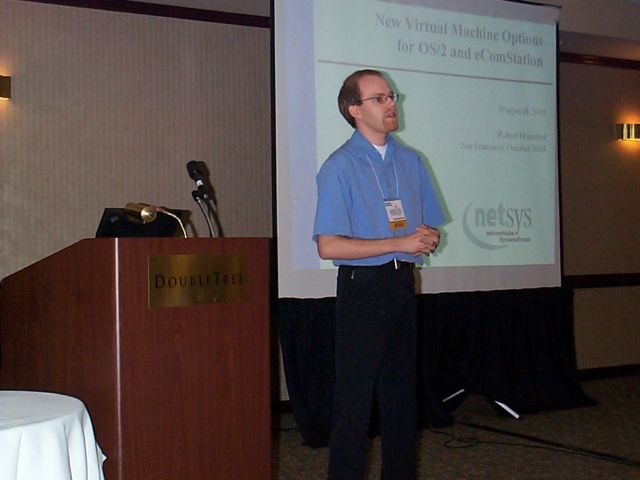
As with VPC, the guest operating system is installed and run from a container file which the guest sees as an IDE drive. The host (at least the windows and the OS/2) will be SMP enabled so you will be able to run two copies of the virtual machine with each being bound to its own CPU. The guest will not see more then a single CPU however.
Supported host platforms currently are: NT4 SP6, Windows2000, XP, WIndows Server 2003, Linux 2.4 and FreeBSD. As stated above the OS/2 version is still in alpha development. Guest platforms supported include OS/2 Warp 3 and above, Windows 3.1, 95, 98, ME, NT, 2000, XP, DOS, Linux 2.2, Linux 2.4. Pricing was discussed but wasn't firm. A beta will be available for a fee of about $30 or so, with beta participants getting a 50% reduction on the final cost of the product. The product plan is beta by year end and GA by 2Q but Bob StJohn did say that all plans are subject to change.
The final version will be sold as a single product with all supported hosts, including OS/2-eCS, Windows, Linux and FreeBSD distributions. You will only be licensed to run one of the host versions at a given time. They will provide FreeBSD on CD1 with the FreeBSD host, and a Linux distro (undetermined at this point) on CD2 with the Linux host. And eComStation, which as we know provides your DOS and Win3.1 support in addition to OS/2, with the OS/2 host and the Windows host. But they will not provide any version of Windows. I believe the estimated price for the final product was $199.
I did make it to Doug Clark's Warp Doctor presentation as well, which looks like it will be an exciting addition to support all OS/2 users on the net. Doug stated that the site was designed to work with all browsers including WebExplorer and Links for those of you who prefer fast over current functionality. First release is tentatively scheduled for December 2003. The UI was designed to require no user maintenance, and includes a plain html mode, Javascript mode and a Java plugin which adds the ability to upload files directly to the Warp Doctor site and allows the originator to modify their data. Drivers, review articles, support comments and software (where allowed) will be stored on the Warp Doctor server either as individual files or in a DB2 database. What is somewhat unique is that the site is designed to point to the original location for the information, but if that is unavailable hen it can be obtained directly off the Warp Doctor server. Up to 5 MB of data can be stored as a DB2 blog field.
Hopefully some of the large group attending Doug's session will turn out for the weekly Warp Doctor meetings on IRC to help with finalizing the project. I wish I could tell you about what happened in all the other sessions but it was impossible to attend all of them as well as help at the VOICE booth and help with running the event. We could have really used 3 or even 4 days this year.
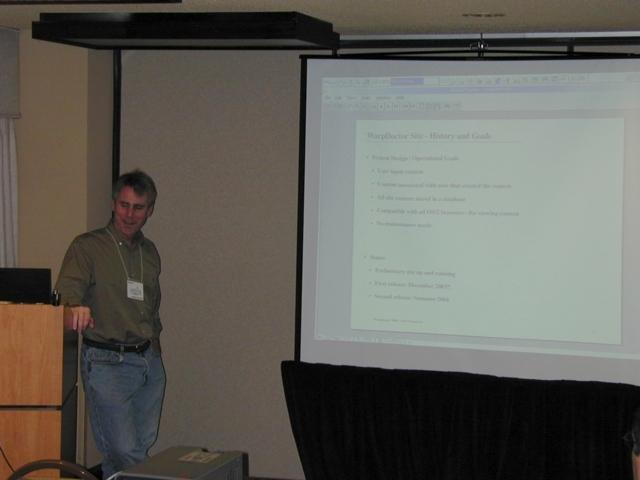
Speaking of VOICE, we had 16 people pay for memberships at this years VOICE table in the exhibit area. The table was manned by several volunteers. A big thanks to all the folks who manned the table. Off the top of my head, that was Bill Loughman, Dr. Jeffrey Race, Doug Clark, Ken Kirchner, Zoltan Bokeny, Matt Walsh, Dan Napier, Tony Butka and Randy Loflin. If I left someone out I apologize and ask you to let me know. Here's a picture of Ken Kirchner at the VOICE table.
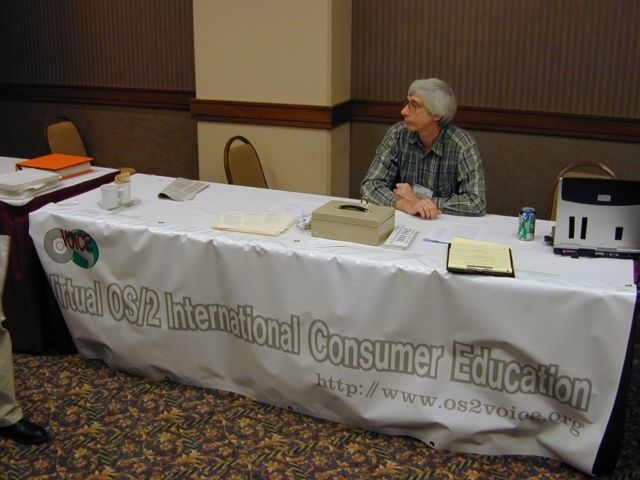
In addition to VOICE there were exhibitor tables from Stalker Software, Computer Data Strategies(Brent Bowlby, President of CDS), Help Desk Computers (Paul Lazaga) along with Blonde Guy Consulting(Neil Waldhauer), as well as Serenity Systems and Mensys (Joachim Benjamins and David van Enckevort). Mensys was selling what stock of VPC/2 they had left.
We gave away a large number of quality prizes this year thanks to Stalker Software, RSJ Software, Scitech Software, CDS, Sundial Systems, O'Reilly books, InFormIT publishers, Bill and Esther Schindler and many others for the donations of prizes. These included a 50 user license for Stalker Software's CommuniGate Pro Messaging Server, 2 licenses for RSJ CD Writer for OS/2, a copy of WSeB, about 40 copies of OpenWatcom on CD from Scitech, 2 copies of BackAgain2000 from CDS, an IDE internal CDR-CDRW drive, a Netgear wireless card, 2 Siemens wireless routers, an SMC Barricade wireless router, CD cases from POSSI, lots of books, shirts, lots of software (where was that guy that was looking for the "Family Fun Pack" on Usenet? We gave away at least one copy in SF. :-) Oh and copies of OS/2 and OS/2 Professional magazines ( "Take the magazine", a line only those who attended would appreciate. ;-)
We will try to get all the presentations uploaded to http://www.warpstock.org/events/library.html , but as of this writing I have only received 4 from the speakers. (Note to all the other speakers please send them to madodel@ptd.net (with "Warpstock 2003 presentation" in the subject) or let me know where I can obtain them.) In addition we have a number of photos taken at the event which will be posted to the site as well.
All I can say is it was a hell of a lot of work, but I had a great time and I hope to meet even more OS/2 and eCS users next year. :-)
References:
|
[Feature Index]
editor@os2voice.org
[Previous Page] [Newsletter Index] [Next Page]
VOICE Home Page: http://www.os2voice.org